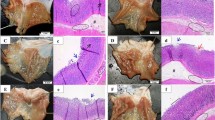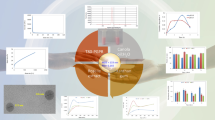Abstract
Kaempferia galanga volatile oil (KVO), the main effective component of the medicinal plant Kaempferia galanga L., possesses a variety of pharmacological activities such as anti-inflammatory, antioxidant, and anti-angiogenic activities and has therapeutic potential for gastric ulcer (GU). However, poor solubility as well as instability limits the clinical application of KVO. In this study, K. galanga volatile oil self-microemulsion solids (KVO-SSMEDDS) were prepared to improve its bioavailability and stability, and the therapeutic effects were evaluated in a rat model with GU. The ratio of oil phase, emulsifier, and co-emulsifier in the KVO-SMEDDS prescription were optimized by plotting the pseudo-ternary phase diagram with the star point design-response surface method. Based on the optimal prescription, self-microemulsifying drug delivery system (SMEDDS) was prepared as solid particles (S-SMEDDS). The prepared KVO-SSMEDDS had a rounded and non-adhesive appearance, formed an O/W emulsion after dissolution in water, and had a uniform particle size distribution with good stability and solubility. It was administered to GU model animals, and the results showed that a certain dose of KVO-SSMEDDS solution could increase the content of gastric mucosal protective factors PGE2, TGF-α, and EGF in gastric tissues and serum, and the expression of inflammatory factors IL-8 and TNF-α was downregulated. Meanwhile, the expression of the NF-κB/COX-2 pathway proteins was inhibited. In conclusion, the prepared KVO-SSMEDDS has good dispersion, solubility, and stability and has a therapeutic effect on rats with GU.
Graphical Abstract








Similar content being viewed by others
Change history
13 December 2023
A Correction to this paper has been published: https://doi.org/10.1208/s12249-023-02719-0
References
Beiranvand M, Bahramikia S. Ameliorating and protective effects mesalazine on ethanol-induced gastric ulcers in experimental rats. Eur J Pharmacol. 2020;888: 173573.
Alharbi KS, Al-Abbasi FA, Alzarea SI, Afzal O, Altamimi ASA, Almalki WH, et al. Effects of the Anthocyanin hirsutidin on gastric ulcers: improved healing through antioxidant mechanisms. J Nat Prod. 2022;85(10):2406–12.
Fayez SM, Elnahas OS, Fayez AM, El-Mancy SS. Coconut oil based self-nano emulsifying delivery systems mitigate ulcerogenic NSAIDs side effect and enhance drug dissolution: formula optimization, in-vitro, and in-vivo assessments. Int J Pharm. 2023;634:122666.
Beiranvand M, Bahramikia S, Dezfoulian O. Evaluation of antioxidant and anti-ulcerogenic effects of Eremurus persicus (Jaub & Spach) Boiss leaf hydroalcoholic extract on ethanol-induced gastric ulcer in rats. Inflammopharmacology. 2021;29(5):1503–18.
Tarnawski AS, Ahluwalia A, Jones MK. Increased susceptibility of aging gastric mucosa to injury: the mechanisms and clinical implications. World J Gastroenterol. 2014;20(42):4467–82.
Ke Y, Zhan L, Lu T, Zhou C, Chen X, Dong Y, Lv G, Chen S. Polysaccharides of Dendrobium officinale Kimura & Migo leaves protect against ethanol-induced gastric mucosal injury via the AMPK/mTOR signaling pathway in vitro and vivo. Front Pharmacol. 2020;11: 526349.
Kamada T, Satoh K, Itoh T, Ito M, Iwamoto J, Okimoto T, et al. Evidence-based clinical practice guidelines for peptic ulcer disease 2020. J Gastroenterol. 2021;56(4):303–22.
Eisner F, Hermann D, Bajaeifer K, Glatzle J, Königsrainer A, Küper MA. Gastric ulcer complications after the introduction of proton pump inhibitors into clinical routine: 20-year experience. Visc Med. 2017;33(3):221–6.
van Diepen S, Coulson T, Wang X, Opgenorth D, Zuege DJ, Harris J, Agyemang M, Niven DJ, Bellomo R, Wright SE, Young PJ, Bagshaw SM, PEPTIC study investigators and the ANZICS Clinical Trials Group. Efficacy and safety of proton pump inhibitors versus histamine-2 receptor blockers in the cardiac surgical population: insights from the PEPTIC trial. Eur J Cardiothorac Surg. 2022;62(2):ezac124.
Kavitt RT, Lipowska AM, Anyane-Yeboa A, Gralnek IM. Diagnosis and treatment of peptic ulcer disease. Am J Med. 2019;132:447–56.
Sheen E, Triadafilopoulos G. Adverse effects of long-term proton pump inhibitor therapy. Dig Dis Sci. 2011;56(4):931–50.
Huang K, Zhang P, Zhang Z, Youn JY, Wang C, Zhang H, et al. Traditional Chinese medicine (TCM) in the treatment of COVID-19 and other viral infections: efficacies and mechanisms. Pharmacol Ther. 2021;225: 107843.
Wang S, Fu JL, Hao HF, Jiao YN, Li PP, Han SY. Metabolic reprogramming by traditional Chinese medicine and its role in effective cancer therapy. Pharmacol Res. 2021;170: 105728.
Salah KM. The postulated mechanism of the protective effect of ginger on the aspirin induced gastric ulcer: histological and immunohistochemical studies. Histol Histopathol. 2015;30:855–64.
Orona-Ortiz A, Velázquez-Moyado JA, Pineda-Peña EA, Balderas-López JL, Tavares Carvalho JC, Navarrete A. Effect of the proportion of curcuminoids on the gastroprotective action of Curcuma longa L. in rats. Nat Prod Res. 2021;35:1903–8.
Jamal A, Javed K, Aslam M, Jafri MA. Gastroprotective effect of cardamom, Elettaria cardamomum Maton. fruits in rats. J Ethnopharmacol. 2006;103:149–53.
Bhatt A, Kean OB, Keng CL. Sucrose, benzylaminopurine and photoperiod effects on in vitro culture of Kaempferia galanga Linn. Plant Biosyst. Int J Deal Aspect Plant Biol. 2012;146(4):900–5.
Kress WJ, DeFilipps RA, Farr E, Kyi DYY. A checklist of the trees, shrubs, herbs, and climbers of Myanmar. Revised by. In: Lace JH, Rodger R, Hundley HG, Chit Ko Ko U (editors), List of Trees, Shrubs, Herbs and Principal Climbers, Etc. Recorded from Burma (vol. 45), Department of Systematic Biology-Botany, National Museum of Natural History (U.S.). 2003. pp. 122–123. http://www.jstor.org/stable/23493222.
Jitsopakul N, Sangyojarn P, Homchan P, Thammasiri K. Micropropagation for conservation of Zingiberaceae in Surin province, Thailand. Acta Hortic. 2017;1167:75–80.
Purba EC, Silalahi M, Nisyawati N. Gastronomic ethnobiology of “terites” - a traditional Batak Karo medicinal food: a ruminant’s stomach content as a human food resource. J Ethn Foods. 2018;5(2):114–20.
Kumar A. Phytochemistry, pharmacological activities and uses of traditional medicinal plant Kaempferia galanga L. - An overview. J Ethnopharmacol. 2020;253:112667.
Bi W, Gao Y, Shen J, He C, Liu H, Peng Y, et al. Traditional uses, phytochemistry, and pharmacology of the genus Acer (maple): A review. J Ethnopharmacol. 2016;189:31–60.
Hao DC, Gu XJ, Xiao PG, Peng Y. Phytochemical and biological research of Fritillaria medicine resources. Chin J Nat Med. 2013;11(4):330–44.
Chittasupho C, Ditsri S, Singh S, Kanlayavattanakul M, Duangnin N, Ruksiriwanich W, et al. Ultraviolet Radiation Protective and Anti-Inflammatory Effects of Kaempferia galanga L. Rhizome oil and microemulsion: formulation, characterization, and hydrogel preparation. Gels. 2022;8:639.
Wang SY, Cai L, Yang N, Xu FF, Wu YS, Liu B. Chemical composition of the Kaempferia galanga L. essential oil and its in vitro and in vivo antioxidant activities. Front Nutr. 2023;10:1080487.
He ZH, Yue GG, Lau CB, Ge W, But PP. Antiangiogenic effects and mechanisms of trans-ethyl p-methoxycinnamate from Kaempferia galanga L. J Agric Food Chem. 2012;60:11309–17.
Itoh K, Tozuka Y, Oguchi T, Yamamoto K. Improvement of physicochemical properties of N-4472 part I formulation design by using self-microemulsifying system. Int J Pharm. 2002;238:153–60.
Yan B, Ma Y, Guo J, Wang Y. Self-microemulsifying delivery system for improving bioavailability of water insoluble drugs. J Nanopart Res. 2020;22:18.
Tang H, Xiang S, Li X, Zhou J, Kuang C. Preparation and in vitro performance evaluation of resveratrol for oral self-microemulsion. PLoS ONE. 2019;14(4): e0214544.
Cui S, Zhao C, Chen D, He Z. Self-microemulsifying drug delivery systems (SMEDDS) for improving in vitro dissolution and oral absorption of Pueraria lobata isoflavone. Drug Dev Ind Pharm. 2005;31:349–56.
Liu Y, Jiang Y, Yang Y, Wang H, Ye J, et al. Houttuynia Essential Oil and its self-microemulsion preparation protect against LPS-induced murine mastitis by restoring the blood-milk barrier and inhibiting inflammation. Front Immunol. 2022;13: 842189.
Hsieh C-M, Yang T-L, Putri AD, Chen C-T. Application of design of experiments in the development of self-microemulsifying drug delivery systems. Pharmaceuticals. 2023;16(2):283.
Huang Y, Zhang S, Shen H, Li J, Gao C. Controlled release of the nimodipine-loaded self-microemulsion osmotic pump capsules: development and characterization. AAPS PharmSciTech. 2018;19(3):1308–19.
Takeuchi K, Amagase K. Roles of cyclooxygenase, prostaglandin E2 and EP receptors in mucosal protection and ulcer healing in the gastrointestinal tract. Curr Pharm Des. 2018;24(18):2002–11.
Konturek SJ, Konturek PC, Brzozowski T. Prostaglandins and ulcer healing. J Physiol Pharmacol. 2005;56:5–31.
Shady NH, Abdullah HS, Maher SA, Albohy A, Elrehany MA, Mokhtar FA, et al. Antiulcer potential of Psidium guajava seed extract supported by metabolic profiling and molecular docking. Antioxidants (Basel). 2022;11(7):1230.
Suganuma M, Yamaguchi K, Ono Y, Matsumoto H, Hayashi T, Ogawa T, et al. TNF-alpha-inducing protein, a carcinogenic factor secreted from H. pylori, enters gastric cancer cells. Int J Cancer. 2008;123(1):117–22.
Dincă AL, Meliț LE, Mărginean CO. Old and new aspects of H. pylori-associated inflammation and gastric cancer. Children (Basel). 2022;9(7):1083.
Sallam A-AM, Darwish SF, El-Dakroury WA, Radwan E. Olmesartan niosomes ameliorates the Indomethacin-induced gastric ulcer in rats: insights on MAPK and Nrf2/HO-1 signaling pathway. Pharm Res. 2021;38:1821–38.
Ermis A, Aritici Colak G, Acikel-Elmas M, Arbak S, Kolgazi M. Ferulic acid treats gastric ulcer via suppressing oxidative stress and inflammation. Life (Basel). 2023;13(2):388.
Jin Y, Zhang M, Wang Y, Lu Y, Liu T, Yang G, et al. Protective effect and potential mechanism of the traditional chinese medicine Shaoyao-Gancao decoction on ethanol-induced gastric ulcers in rats. Evid Based Complement Alternat Med. 2022;2022:3069089.
Mahmoud MF, Nabil M, Abdo W, Abdelfattah MA, El-Shazly AM, El Kharrassi Y, et al. Syzygium samarangense leaf extract mitigates indomethacin-induced gastropathy via the NF-κB signaling pathway in rats. Biomed Pharmacother. 2021;139: 111675.
Yin P, Zhang Z, Li J, Shi Y, Jin N, Zou W, et al. Ferulic acid inhibits bovine endometrial epithelial cells against LPS-induced inflammation via suppressing NK-κB and MAPK pathway. Res Vet Sci. 2019;126:164–9.
Peskar BM. Role of cyclooxygenase isoforms in gastric mucosal defence. J Physiol Paris. 2001;95:3–9.
Liu R, Zhu N, Hao Y, Liu X, Kang J, Mao R, et al. The protective effect of walnut oligopeptides against indomethacin-induced gastric ulcer in rats. Nutrients. 2023;15(7):1675.
Hajjar B, Zier KI, Khalid N, Azarmi S, Löbenberg R. Evaluation of a microemulsion-based gel formulation for topical drug delivery of diclofenac sodium. J Pharm Investig. 2018;48:351–62.
Constantinides PP. Lipid microemulsions for improving drug dissolution and oral absorption: physical and biopharmaceutical aspects. Pharm Res. 1995;12(11):1561–72.
Umar MI, Asmawi MZ, Sadikun A, Atangwho IJ, Yam MF, Altaf R, et al. Bioactivity-guided isolation of ethyl-p-methoxycinnamate, an anti-inflammatory constituent, from Kaempferia galanga L. extracts. Molecules. 2012;17(7):8720–34.
Serafim CAL, Araruna MEC, Alves Júnior EB, Silva LMO, Silva AO, da Silva MS, et al. (-)-Carveol prevents gastric ulcers via cytoprotective, antioxidant, antisecretory and immunoregulatory mechanisms in animal models. Front Pharmacol. 2021;12: 736829.
Mantovani A, Dinarello CA, Molgora M, Garlanda C. Interleukin-1 and related cytokines in the regulation of inflammation and immunity. Immunity. 2019;50(4):778–95.
Qu Y, Li X, Xu F, Zhao S, Wu X, Wang Y, et al. Kaempferol alleviates murine experimental colitis by restoring gut microbiota and inhibiting the LPS-TLR4-NF-κB Axis. Front Immunol. 2021;12(7): 679897.
Huang WC, Wu SJ, Tu RS, Lai YR, Liou CJ. Phloretin inhibits interleukin-1β-induced COX-2 and ICAM-1 expression through inhibition of MAPK, Akt, and NF-κB signaling in human lung epithelial cells. Food Funct. 2015;6(6):1960–7.
Acknowledgements
The authors are thankful to the Guangdong Pharmaceutical University Ethics Committee for their kind guidance in the animal experiments, and the School of Chinese Material Medica of Guangdong Pharmaceutical University for providing the technical platform.
Funding
This project was funded by the Guangdong Natural Science Project (No. 51348190) and National TCM Backbone Innovative Talent Training Program (State Administration of Traditional Chinese Medicine) (National TCM Human Education Letter (2019) No. 128).
Author information
Authors and Affiliations
Contributions
Conceived and designed the experiments: DL, RL, and JS.
Performed the experiments: DL, RL, ZZ, BY, and CQ.
Contributed analytic tools: FM and JS.
Performed data analysis: DL, RL, ZZ, BY, CQ, and JS.
Wrote or contributed to the writing of the manuscript: DL, RL, ZZ, BY, CQ, FM, and JS.
Corresponding authors
Ethics declarations
Conflict of Interest
The authors declare no competing interests.
Additional information
Publisher's Note
Springer Nature remains neutral with regard to jurisdictional claims in published maps and institutional affiliations.
Supplementary Information
Below is the link to the electronic supplementary material.
Rights and permissions
Springer Nature or its licensor (e.g. a society or other partner) holds exclusive rights to this article under a publishing agreement with the author(s) or other rightsholder(s); author self-archiving of the accepted manuscript version of this article is solely governed by the terms of such publishing agreement and applicable law.
About this article
Cite this article
Liu, D., Liu, R., Zhuang, Z. et al. Preparation of Self-microemulsion Solids of Kaempferia galanga (L.) Volatile Oil and Its Effect on Rats with Gastric Ulcer. AAPS PharmSciTech 24, 243 (2023). https://doi.org/10.1208/s12249-023-02693-7
Received:
Accepted:
Published:
DOI: https://doi.org/10.1208/s12249-023-02693-7




